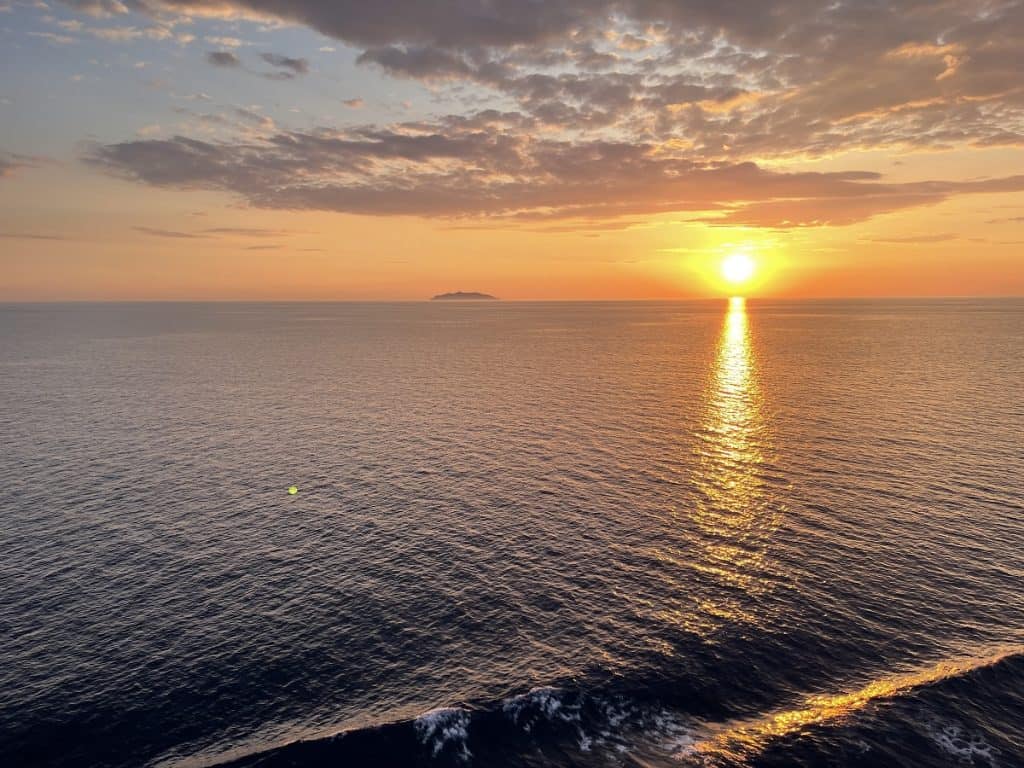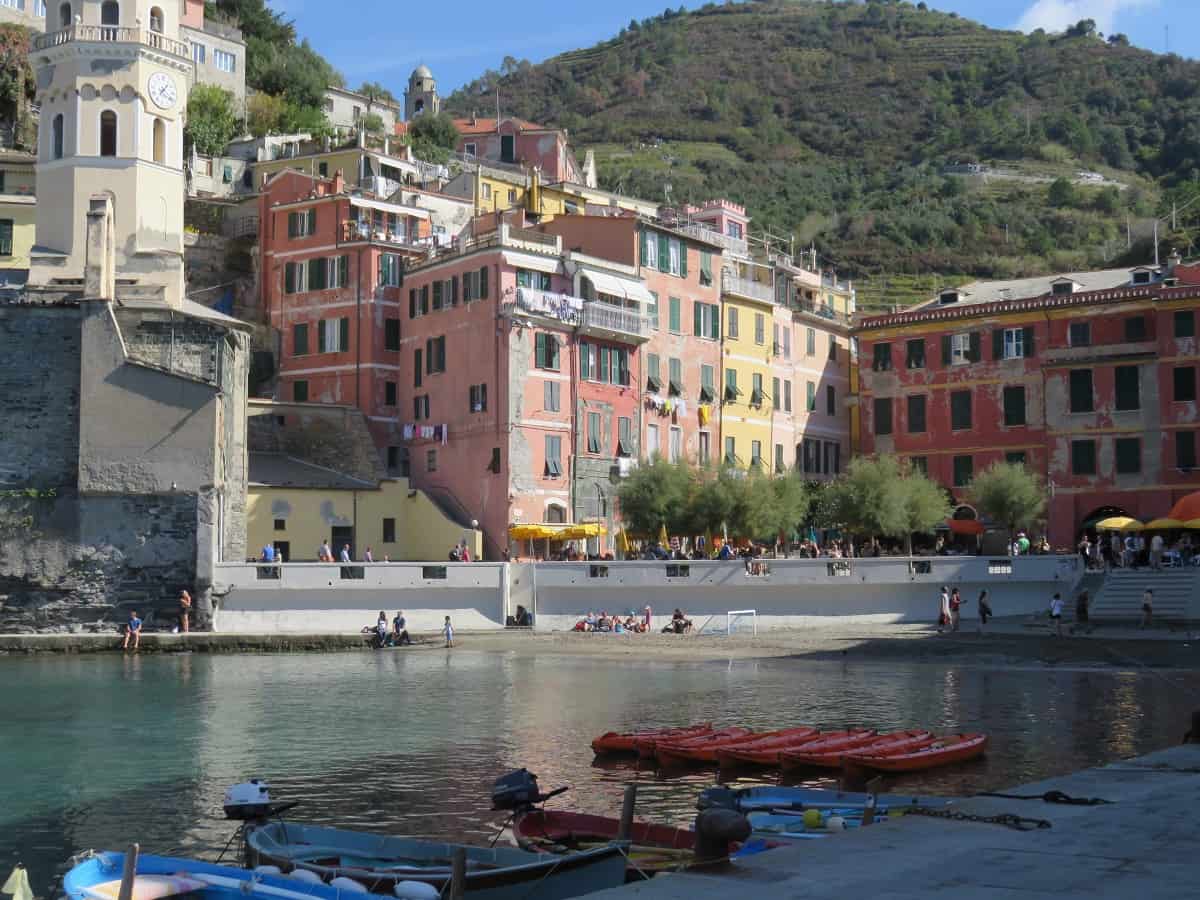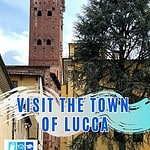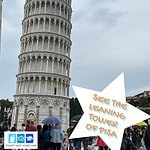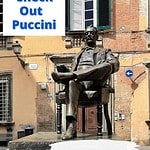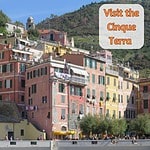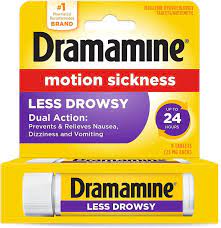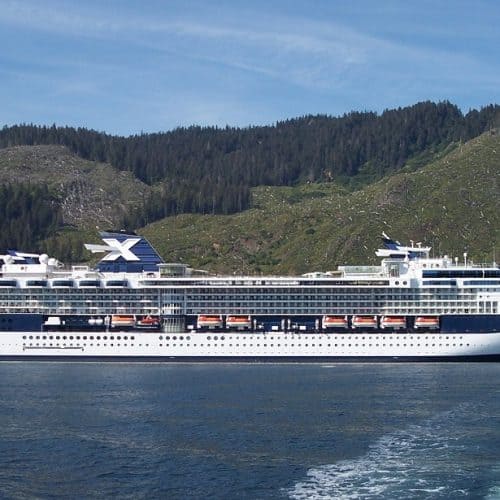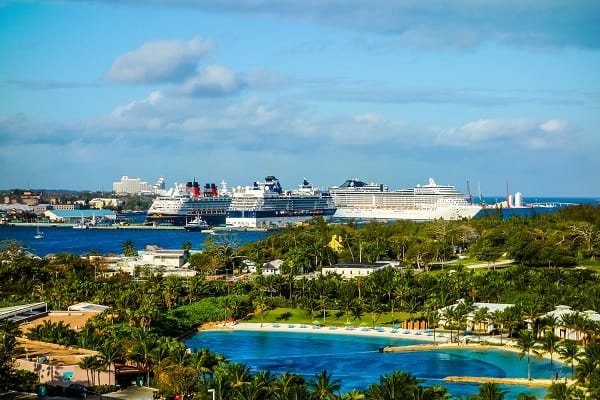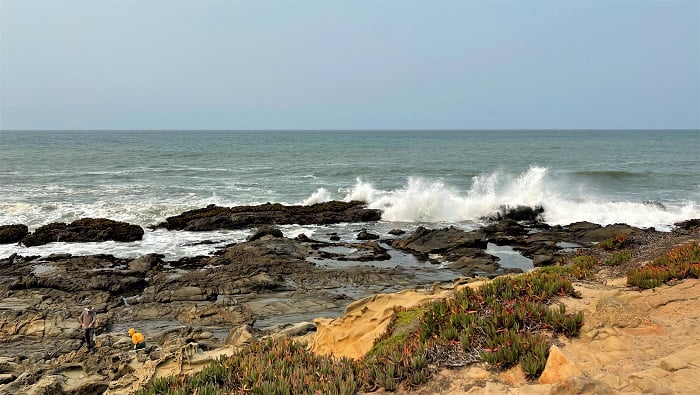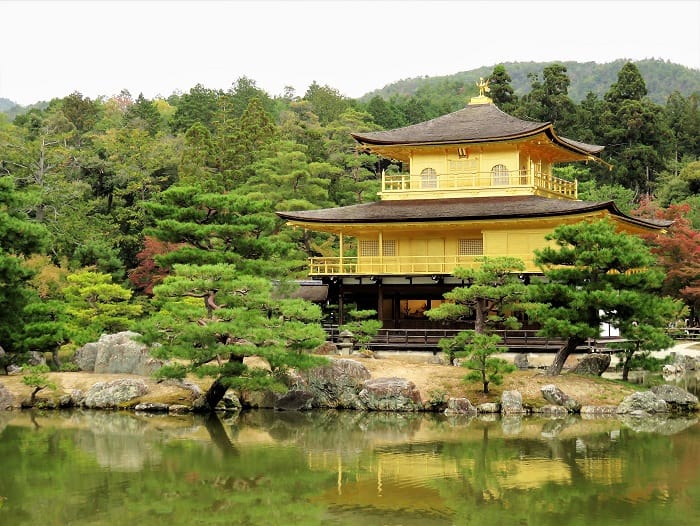One Day In The Livorno Cruise Port – 2 Great Tour Choices
This post is part of a series on what to do when you have one day in port on a Cruise. You can find more posts from this series on my page, How To Spend One Day In Port.
Livorno is the third largest port in Italy and a frequent port on cruises to Italy. Located on the country’s northwest coast, the port provides cruisers excellent access to the Cinque Terre and the Tuscan City of Florence. Closer to Livorno, you have Pisa with its infamous “leaning tower” and the medieval walled town of Lucca.
If you take a Mediterranean cruise, there is a good chance you will dock in the cruise port of Livorno. This is where the Tuscan Coast meets the Mediterranean Sea. Actually, the Ligurian Sea, The Med, is technically south of here. But many feel this is the Med. We’ve been fortunate to dock at the Livorno Cruise Port twice!
This article may contain affiliate links. We may earn a commission if you use these links to buy products or services. Please see our disclosure policy for full details. Thanks.
Cruise Ship Shore Excursions In Livorno
Many cruise passengers choose to take shore excursions from the cruise ship. These trips are curated by the cruise company and are generally very good.
The most significant upside you always hear is that if you are on a ship’s excursion, the ship won’t sail without you if you get delayed. The biggest downside to ship-offered shore excursions is that they are often quite expensive.
A Florence shore excursion is among the most popular trips from the Livorno cruise port. Some of these shore excursions include a stop in Pisa. Why Florence? Well, you have the Accademia, with Michelangelo’s statue of David, the Cathedral & Baptistry, Uffizi Gallery, Ponte Vecchio, and Palazzo Pitti, with Boboli, its beautiful gardens. And there is so much more.
But here’s the rub, If you dock in the Livorno cruise port from 8:00 am and set sail at 6:00 pm. You are left with around 8 hours to spend ashore.
The full-day shore excursion to Florence starts with a bus trip about 1-1/2 hours long. This means the round trip takes 3 hours of your time in port. This leaves you with little time, just 5 hours, to spend visiting Florence.
Florence is a city with rich history; you want more time. If you have been to Florence before or if you know you will never be here again. Go to Florence.
Remember to set aside an hour or so for Pisa (you must capture that iconic photo)! That means that, most likely, you will only have time to take in one of the fantastic sites I mentioned above.
If I had to select just one thing to see, I would go to the Accademia and see the statue of David. I will always choose Michangelo’s works over almost anything else. Buy your tickets to the Accademia in advance and skip the line to save time.
The Cinque Terre: An Easy Day Trip From The Livorno Cruise Port
When we first had a cruise dock at the Livorno Port, we went all in along with six other passengers on a semi-private day trip to the Cinque Terre. The all-in portion of this was the length of the tour, a good eight hours, not the cost.
Sharing a tour like this with other cruise passengers allows for a reasonable per-person rate. Yes, this was an excursion offered by the cruise ship, but at a much higher cost.
If you check out your sailing on Facebook or CruiseCritic, you can often find shipmates wanting to share a private tour, or you can post a tour and ask for folks to join. This is what we did. A great way to lower your cost and meet potential new friends!
The cost for this type of full-day private shore excursion is generally going to be around $100 per person. This does not include any food, drink, or admission to museums that may charge a fee.
Vernazza, Corniglia And Riomaggiore
The five small towns of the Cinque Terre and Portovenere are UNESCO World Heritage Sites: Monterosso, Vernazza, Corniglia, Manarola, and Riomaggiore. It’s a pilgrimage of sorts to take a week or so and walk the hillside trail that connects the towns. We had planned to make this trek on an earlier trip to Italy, but our plans got derailed by family matters that called us home.
Since we only have this one day, our tour is a much smaller sampling. After an early morning pick-up at the port, we have a long bus ride (1½ hours) to Portovenere, our first stop, where we catch our ferry to the Cinque Terre.
A Quick Tour of Portovenere
Before jumping on the ferry, our driver/guide for the day encourages us to walk through the town of Portovenere and out to the point where the Church of San Pietro stands.
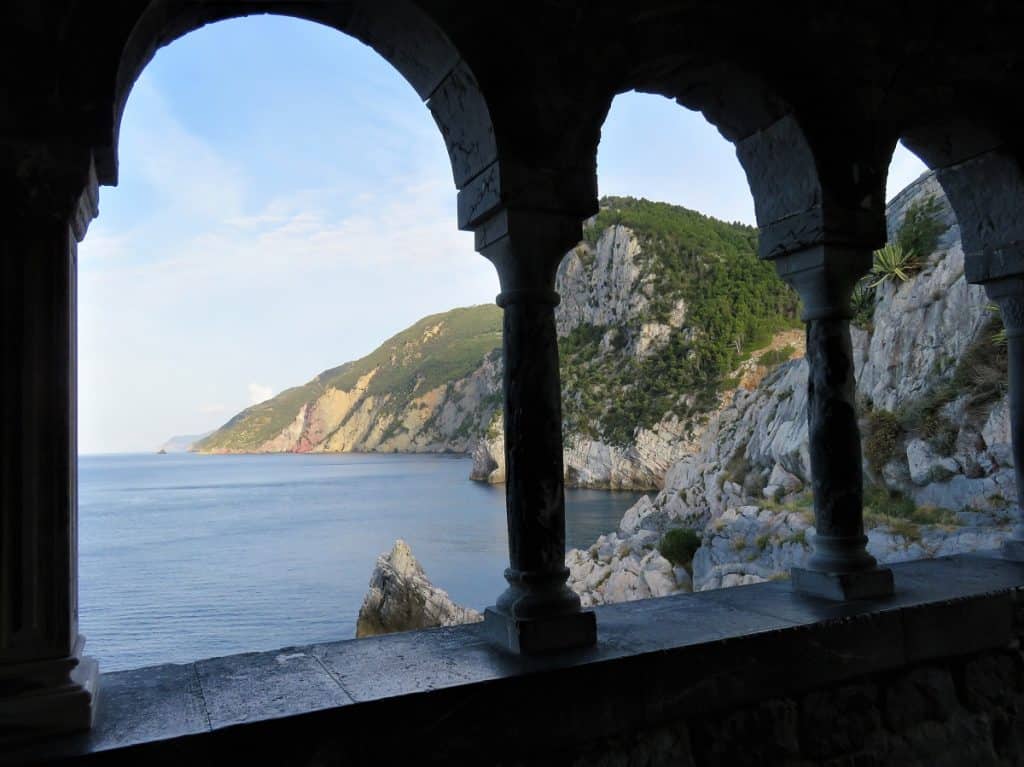
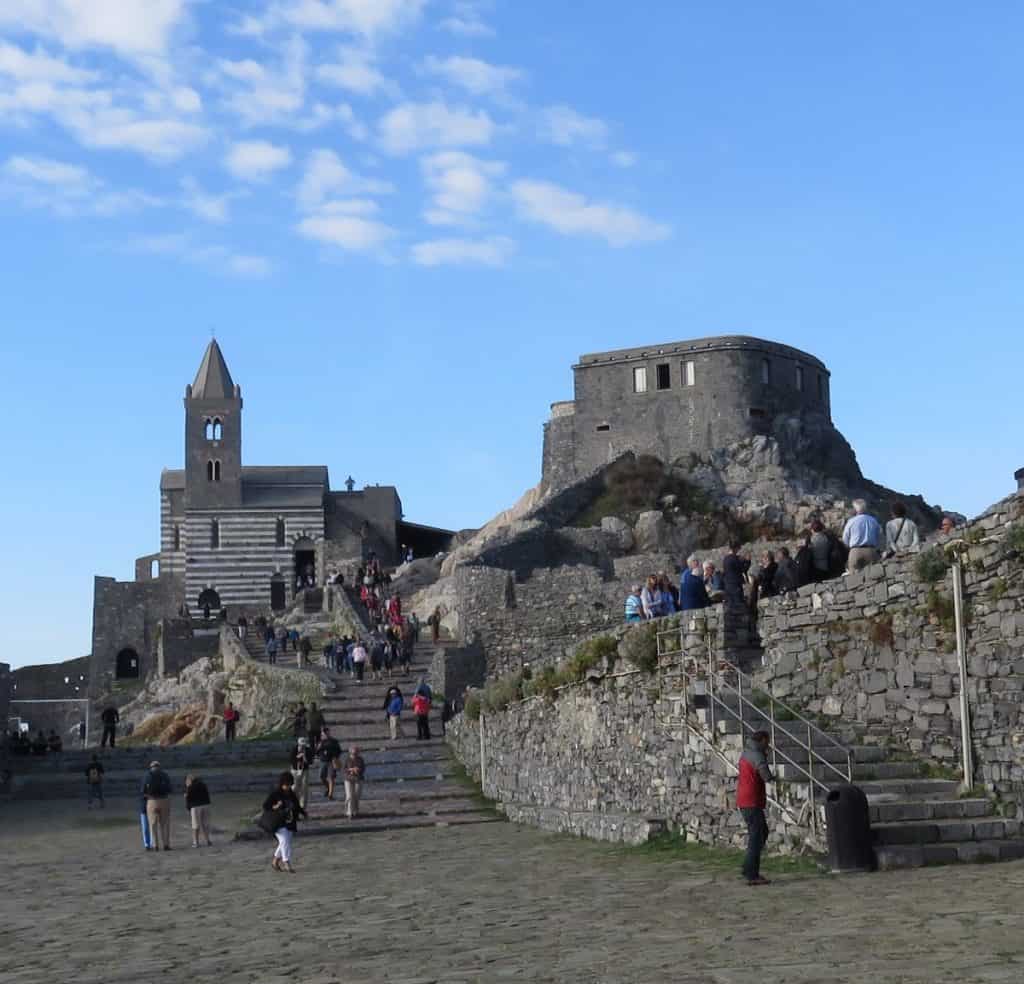
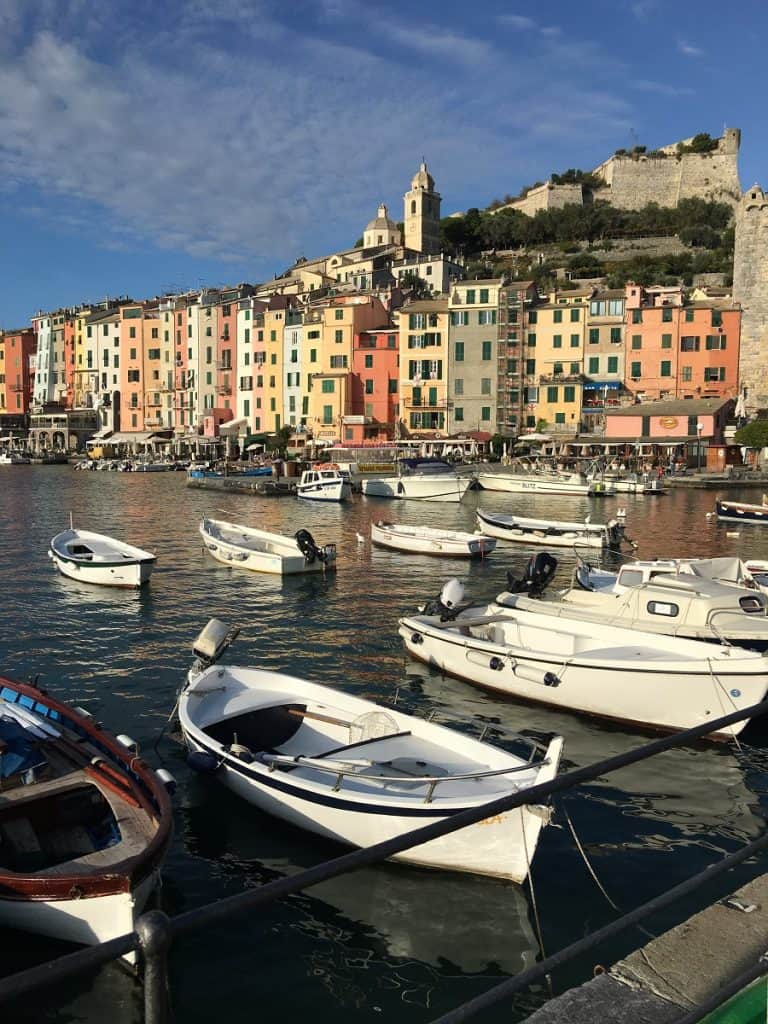
This short walk from the dock takes us past Doria Castle, San Lorenzo Church, and the Grotta di Lord Byron. Each stop offers fantastic views of the sea and coast.
Once back at the dock, we are guided onto a ferry to sail up to Vernazza. By the way, the ferry cost is not included in the tour price. The ferry one way is an additional 20€ per person.
Lunch And A Hike In Vernazza
Vernazza is the 2nd most northern town, just south of Monterosso. This boat trip, which lasts about an hour, takes you close to the shore, and the views of the other town and coastline are awe-inspiring.
We arrive in Vernazza just before noon. It is a little early for lunch, but we can see that the tables at the outdoor cafés around the small port are already starting to fill up. We quickly grab one of the last tables and tuck into one of my favorite seaside delicacies, mussels, and Frites.
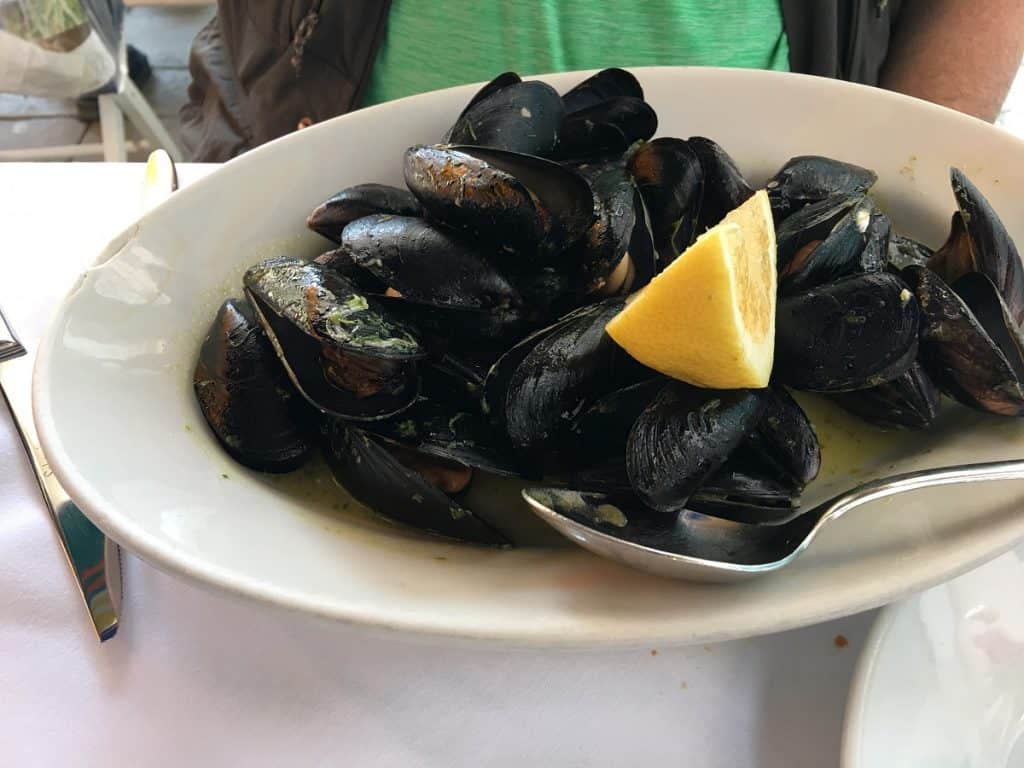
This is a good tip for those who take this tour. Eat first, see the town next. By the time we ordered, there were no tables to be found anywhere. Some of our tour mates were frustrated that they did not get seated.
After lunch, we walk up the narrow streets of Vernazza towards the train station at the top of the town. Looking down the streets, you see where the local fishermen have hauled their boats up from the harbor and tied them up by their homes. I cannot imagine doing this every day.
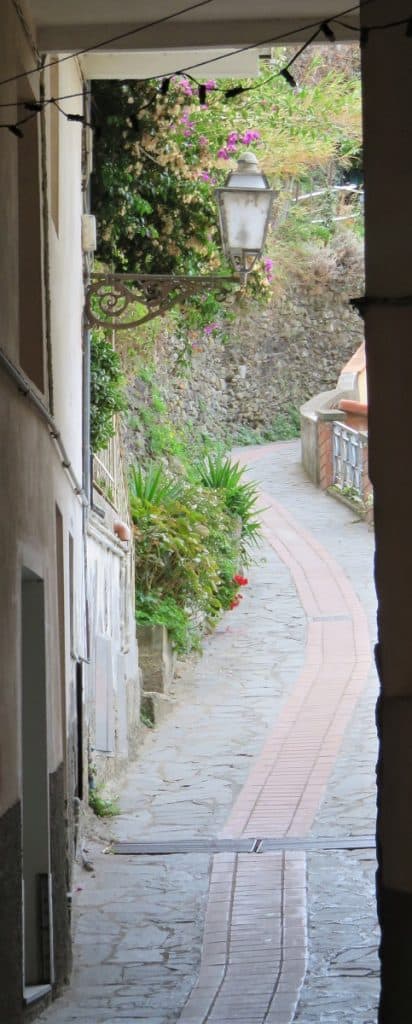
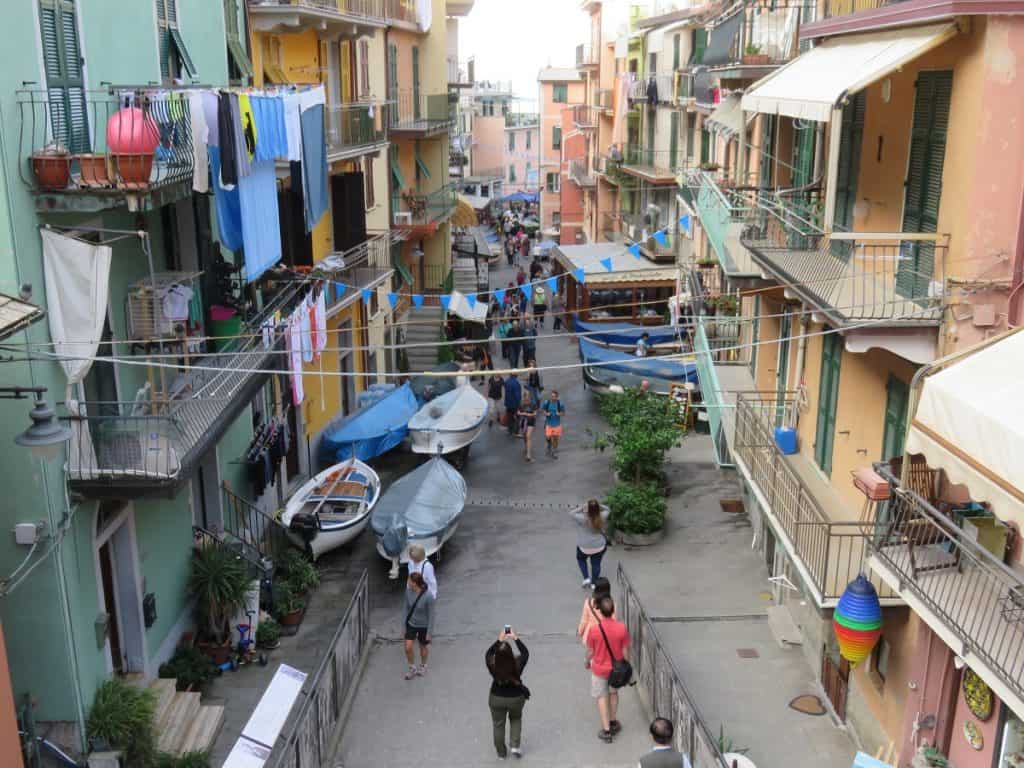
The views looking down these small alleys between the homes and businesses make you wonder how the villages have held on for nearly a thousand years.
Back down at the dock, we have some time before our driver picks us up. We sit on the sea wall and people-watch in the sun until it is time to meet our driver and head to the next town.
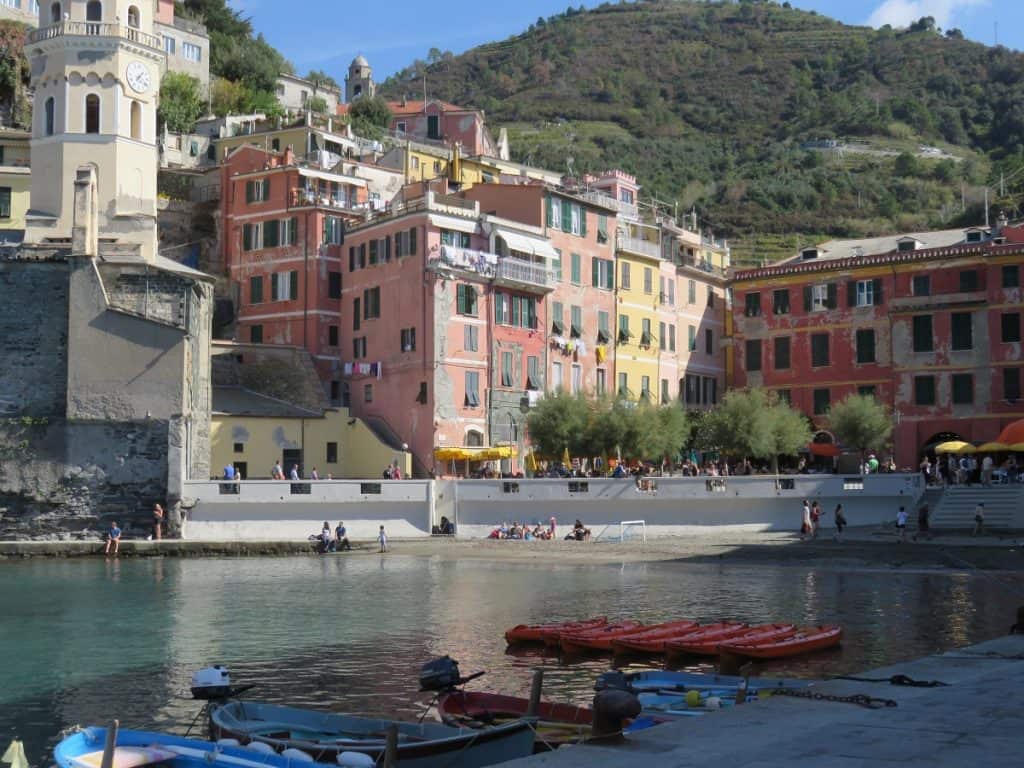
Corniglia The Town That Doesn’t Touch The Sea
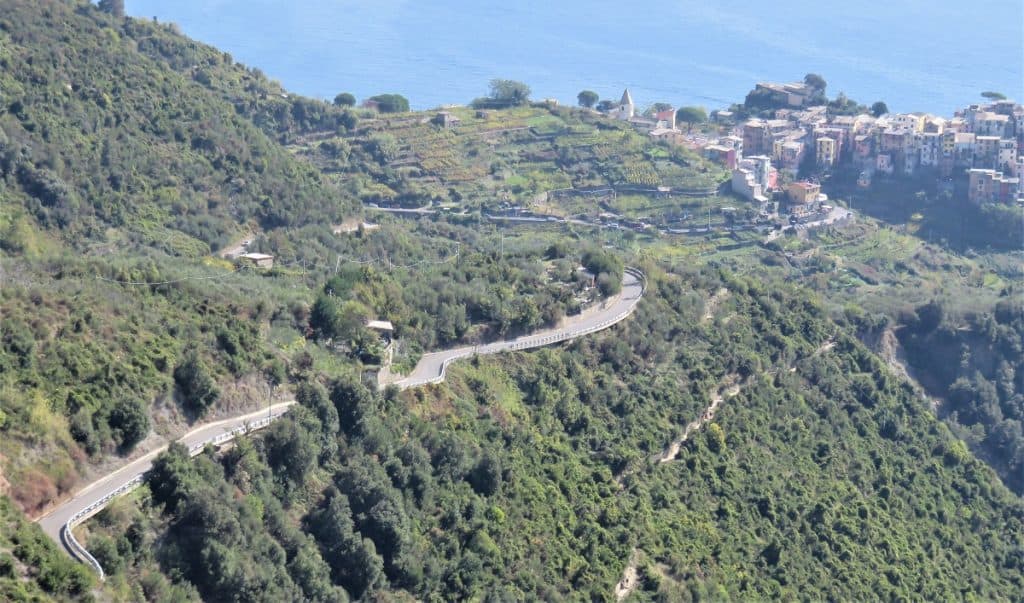
On the way to Corniglia, our driver takes us through the hills above the towns. Driving slowly, he shows us how the hillsides are terraced to make farming possible. Also, with all the twists and turns, going slow is the only way to stay alive.
If you get easily motion sick, don’t forget your Dramamine or wristbands. You will want them for this drive.
Corniglia is the only village in the Cinque Terre that does not meet the sea. The town is perched on top of sheer cliffs above the coast. This area is the most agriculturally active in the region and is known for its wines. If you are hoping to do some wine tasting, this would be the place to do so.
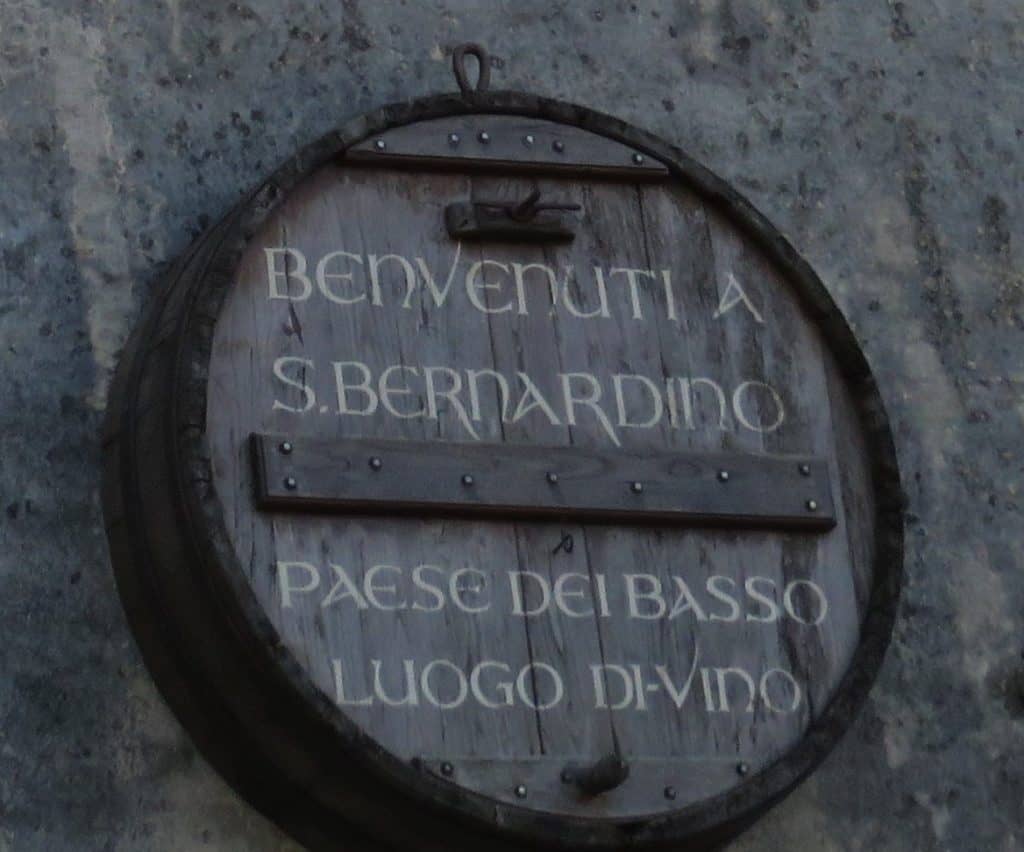
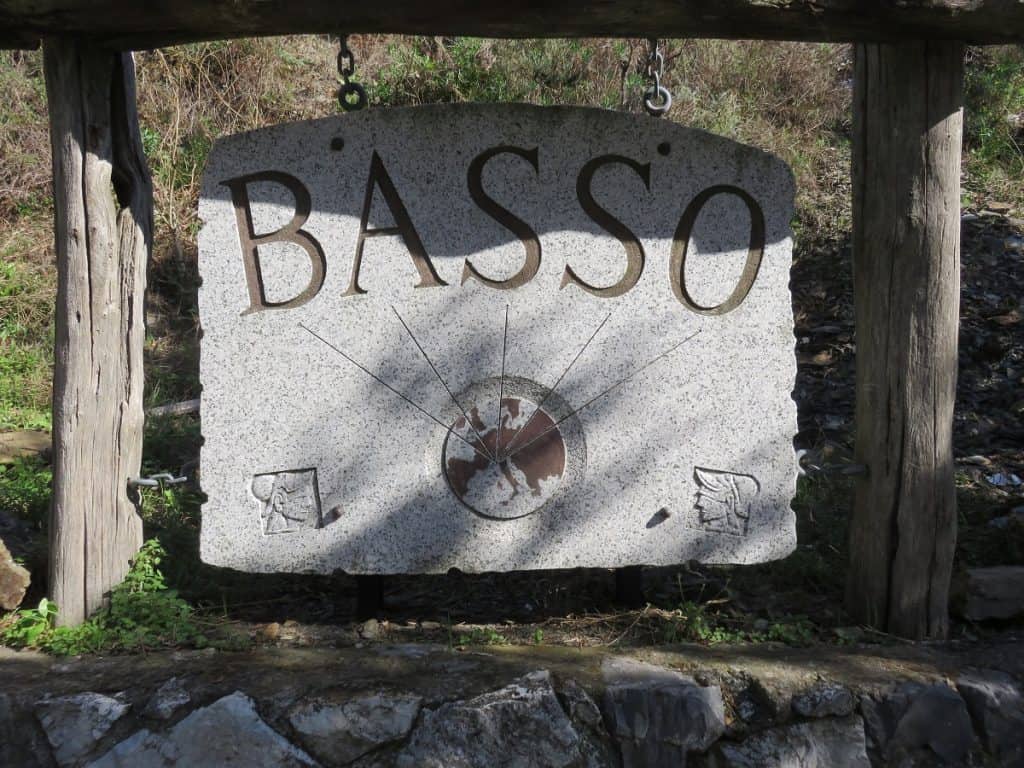
Our driver stops near one such vineyard and shows us the baskets attached to the pulley system that takes the harvested fruit and vegetables grown on the hillsides back down to the village.
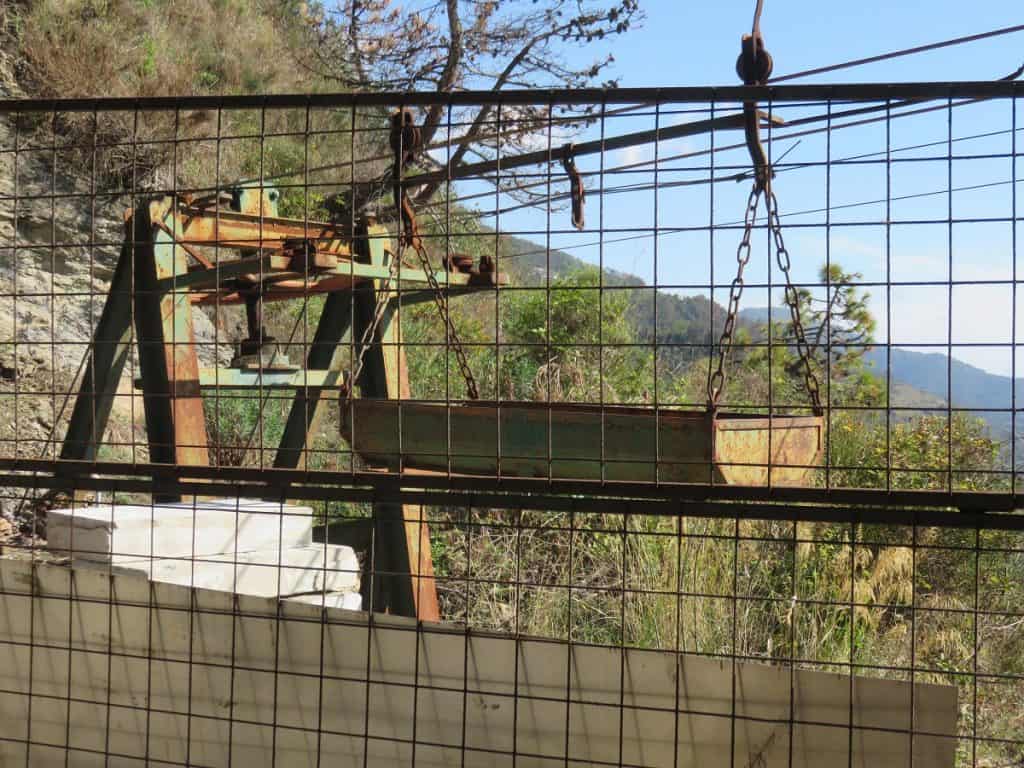
In town, we stop by Largo Taragio in front of the Oratory of Disciplinati di Santa Caterina. In the square is a statue erected as a monument to those who fell in 1926 when the Fascist government of Mussolini took over Italy.
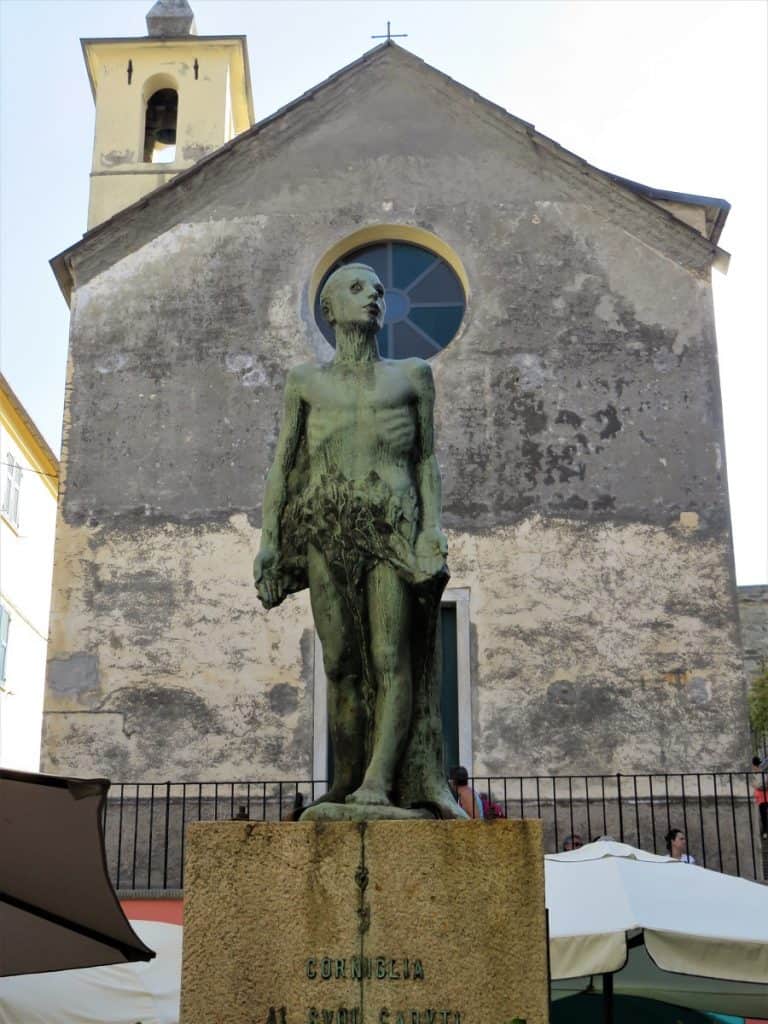
Leaving The Cinque Terre And Driving Back To The Port Of Livorno
Corniglia is the last village we have a chance to walk through. We make one more stop on a hilltop overlooking Riomaggiore, but there is a long drive ahead to get back to the cruise ship. Our driver navigates to the major highway and heads south back to Livorno.
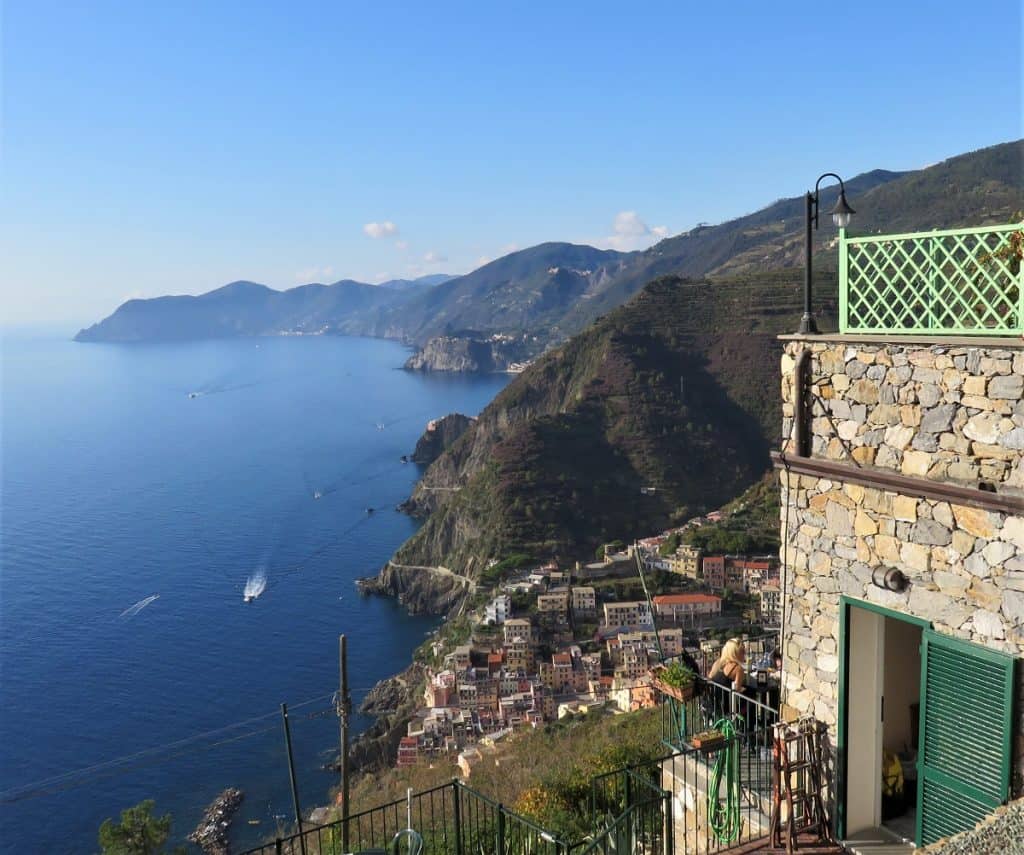
Generally, these long drives are not exciting. It’s the price you have to pay to see the sites from the port your ship docks in.
However, it is late afternoon now, and the sun is low in the west over the ocean. Our driver points out the hills of Carrara, where the world-famous marble is from. The hillside cuts offer a brilliant sheen from the sun hitting the marble cliffs.
We arrive back at our ship around 5:30 pm, beating the all-aboard call by half an hour. It’s been a long day, but now we can clean up and head to dinner.
Things To Do On Your Own When Docked In Livorno
This past spring, the Livorno cruise port was our last stop before Rome (Civitavecchia) at the end of our 1st Transatlantic On Celebrity Cruises Reflection.
We know we don’t want to go to Florence with a long bus ride and a short time in town. We’ve been to Florence and know how much there is to see. Also, this is the last day of the cruise, and we need to pack our suitcases and be ready to disembark in the morning. A relaxing day is required.
The ship has a wide selection of shore excursions to locations closer to Livorno. Still, they all seem pretty pricey for what is offered. So we look at some of the companies that provide tours in the area and find an easy day trip from the city center to visit Pisa and Lucca from Get Your Guide.
Livorno’s city center is the starting point of the tour. The port is about a 10-minute bus ride from the City, but shuttle buses run from the cruise ship dock every 20 minutes. It’s not a free shuttle; the cost for cruise passengers is 10 € for a round-trip ticket. That’s a “return ticket” for all those outside the US.
We get to the bus stop in the town center and meet up with about a dozen other cruisers like us taking this independent day tour. We arrive in town a bit early, hoping to grab a pastry and coffee at a local shop. But today is Sunday, and none of the shops are open this early, not even for a quick coffee.
Even though it’s the end of April, it’s raining and a bit chilly this morning. Many of our fellow passengers are unhappy to be standing outside.
I’m wearing my lightweight puffer jacket with a hood, so I’m not so bothered by the rain. This jacket is so easy to pack it almost always makes sense to bring it along.

After a few minutes, a representative from the tour company arrives and explains a bit about our day. Shortly after that, the bus arrives, and we pile in and head off to Pisa.
This trip is only transportation to the two locations, which is ok with us. We like touring on our own from time to time. There is a guide on the bus; she gives a map of the towns and tells us some history of the area while we travel. While the tour company provides transportation to and from the City, this day will be a walking tour. Wear comfortable shoes!
Pisa And Its Famous Leaning Tower
About a 30-minute bus ride north of Livorno is Pisa. Now a good size city, Pisa has been a major maritime port since as early as the 1st century CE.
Home to the University of Pisa dating back to the 12th century and Scuola Normale Superiore de Pisa founded by Napoleon in 1810. Pisa has over twenty historic churches, medieval palaces, and fine architecture from many eras. But what do all the tourists come to see? The Leaning Tower of Pisa.
When we arrive at the bus and car park in Pisa, the guide from the bus leads us through town to the edge of the pedestrian zone outside of the walled area of the Piazza Dei Miracoli. The guide leaves us after reminding everyone that the bus leaves for Lucca in an hour and a half.
Watches set, we head out to sightsee. The area consists of souvenir shops and quick-stop eateries. Finally, we grab a hot drink and a bite to eat. Then along with a couple of hundred (maybe a thousand) other tourists, we head towards the Tower.
Just before reaching Lion’s Gate, the northwest corner of Piazza Dei Miracoli, I notice an opening leading into a cemetery.
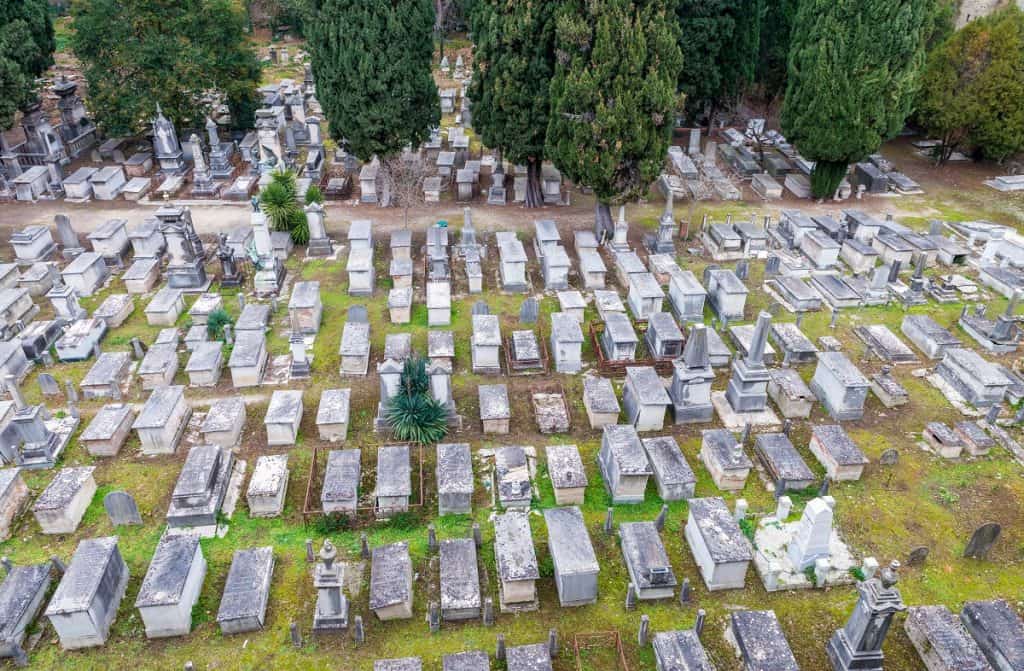
I’m a big fan of old cemeteries, so we make a quick detour and go in. Turns out this is the Jewish graveyard (Cimitero Israelitico). I’m surprised that the burial sites are above ground, much like New Orleans. But as we are so close to the river, I guess this makes sense.
Piazza Dei Miracoli (The Square Of Miracles), Also Known As The Field of Miracles
Inside the ancient walls stand the buildings everyone has come to see. The Duomo or Cathedral of Pisa (1063 – 1092), the Baptistry (1152 – 1363), and the Campanile (the Leaning Tower of Pisa). The Campanile (1173 – 1372) was built as a stand-alone bell tower for the Cathedral.
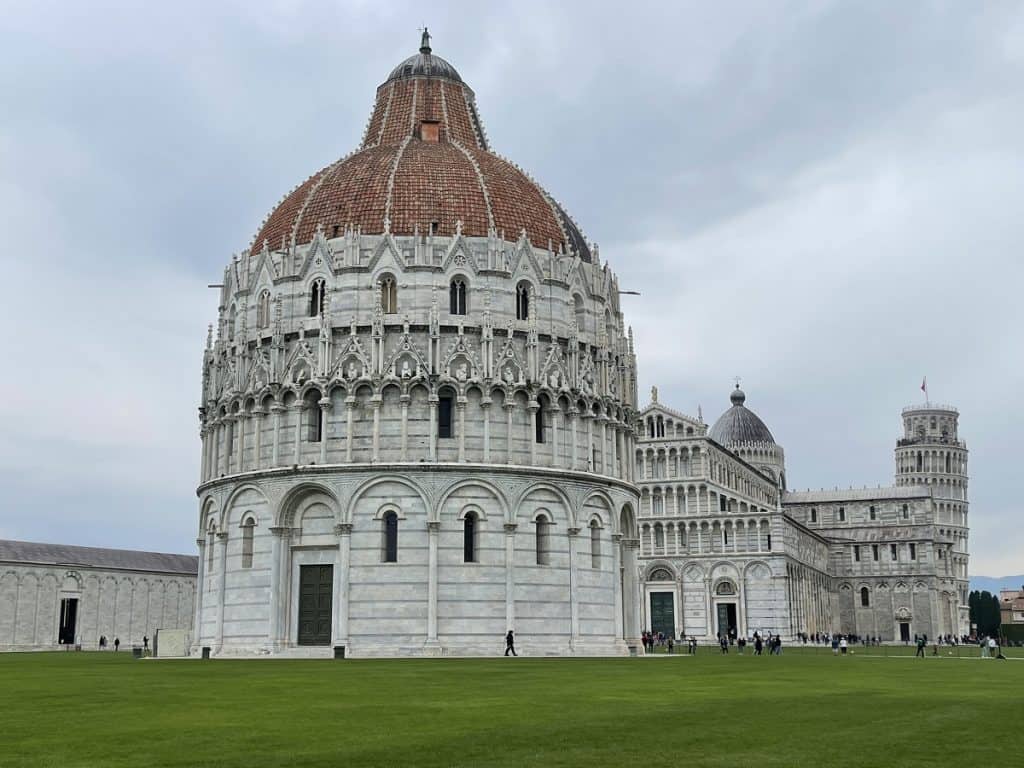
Everyone has probably heard stories about the construction of the bell tower. TLDR: About five years after construction started, the Tower began to sink on its south side. Weak soils and a poor foundation were the most likely causes. The Tower then was only three stories high.
The Church decided to stop construction and allow the building to settle. And so it sat for 100 years! In 1272, when construction resumed, the architects chose to build the upper floors with one side taller than the other.
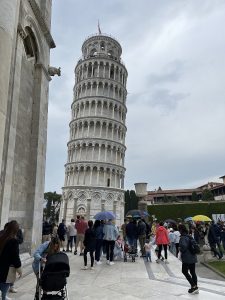
When the Tower reached its full height (seven floors) in 1319, there was only a one-degree lean. However, the south end of the Tower continued to sink, and by 1990 the lean was a full five degrees.
Today work has been done to stabilize this elegant piece of architecture. It is still the Leaning Tower of Pisa, but since 2010, the lean has been reduced to just four degrees.
You can tour each of these buildings inside and out. The Campanile has 296 steps inside from top to bottom. And yes, you can walk (hike) your way up to the top. The seven main bells in the Tower are cast to the musical scale.
If you plan to tour the interior of the Baptistry, Duomo, and walk to the top of the Campanile, I suggest you take a guided tour. This allows you to skip the lines and head to the front. Otherwise, you may be waiting for your chance to enter for quite a while.
We did silly tourist things with only an hour to spend here in Pisa. Taking selfies and enjoying a walk in the rain.
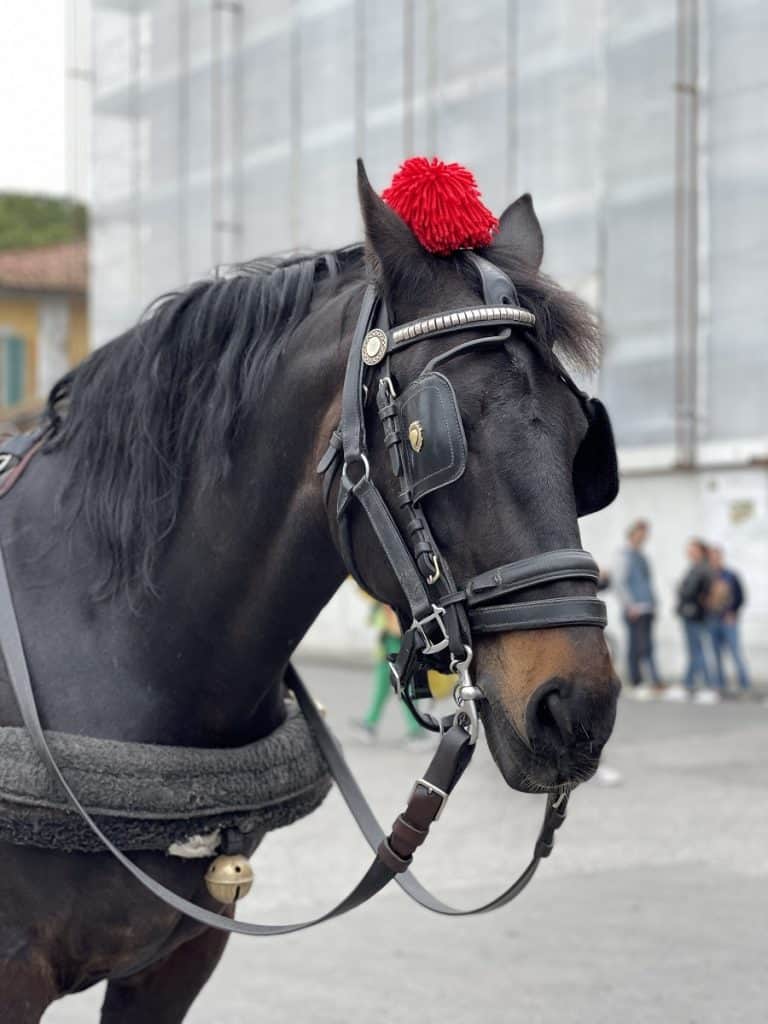
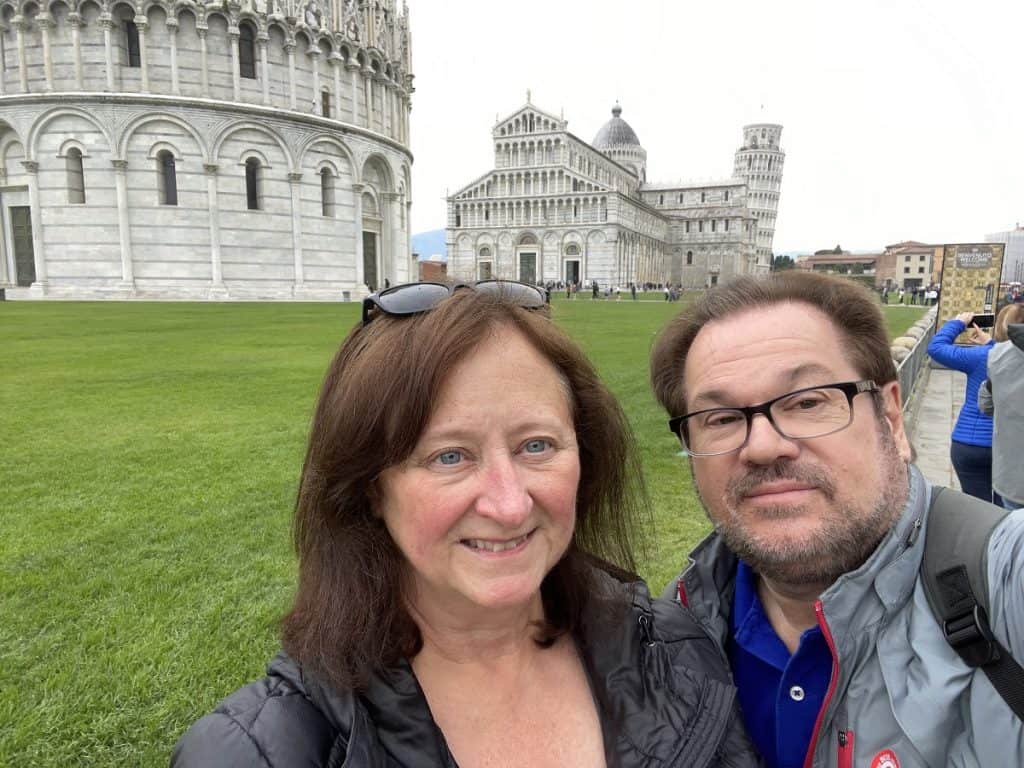
Lucca: A Walled Medieval City
Back on the bus, we head to Lucca, a medieval village with intact encircling walls. We stop just outside Porta Santa Maria (the north gate), and our guide walks us to where our meeting place will be in three hours.
I know this will sound like all we do is eat, but it’s one o’clock, and all we’ve had today is a coffee and pastry. We find the excellent Ristorante Pizzeria K2 with tables outside calling to us.
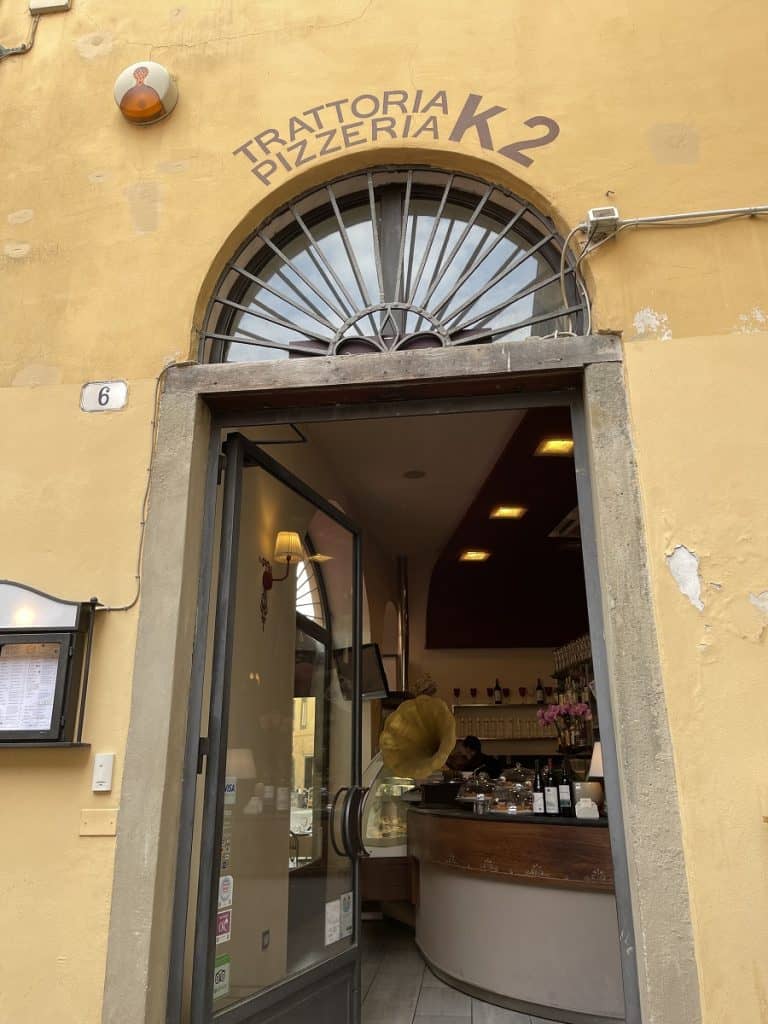
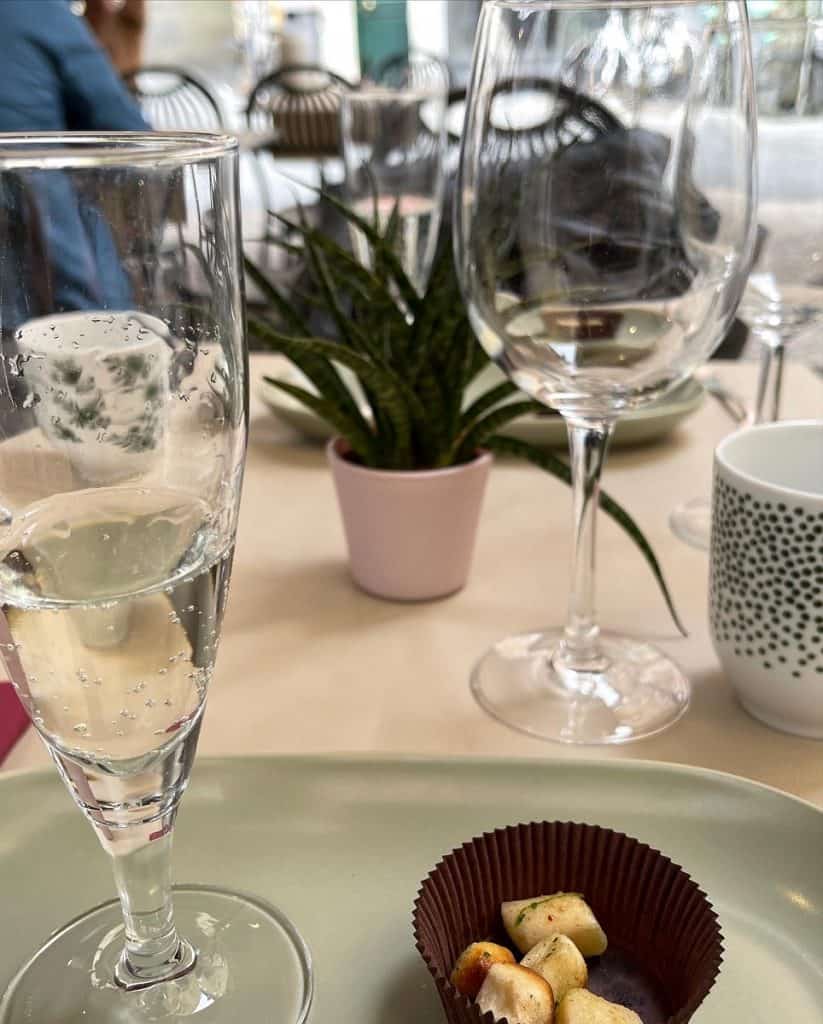
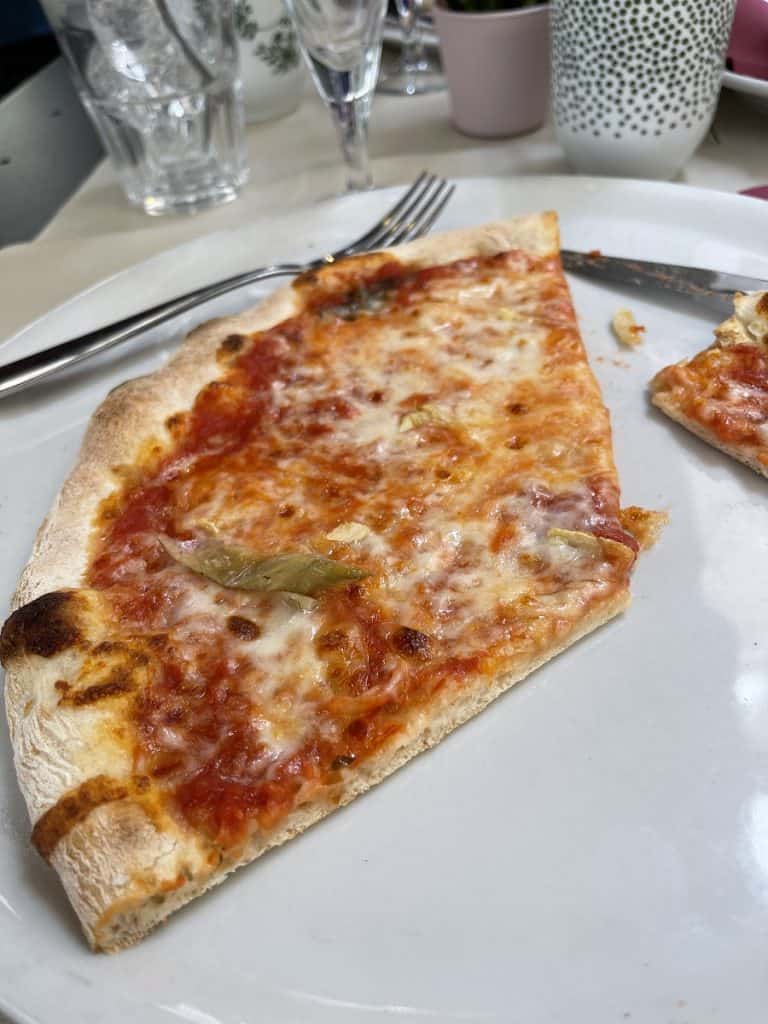
While sipping a glass of wine and munching down some terrific pizza, we review our map and plan our tour of Lucca.
Lucca has many historic sites, but you must decide the best things to see when you are short on time. Fortunately, the village is small, so the walking time between chosen sites is short.
We are on the Via dell’Anfiteatro, a road so named as it circles what used to be the Roman Amphitheater. The theater is long gone. But the homes and businesses built around the outside of the theater still exist.
Guinigi Tower is the first thing we head for. At nearly 45 meters in height, it easily is one of the tallest buildings in Lucca. Wealthy families back in the 1300s built bell towers as status symbols.
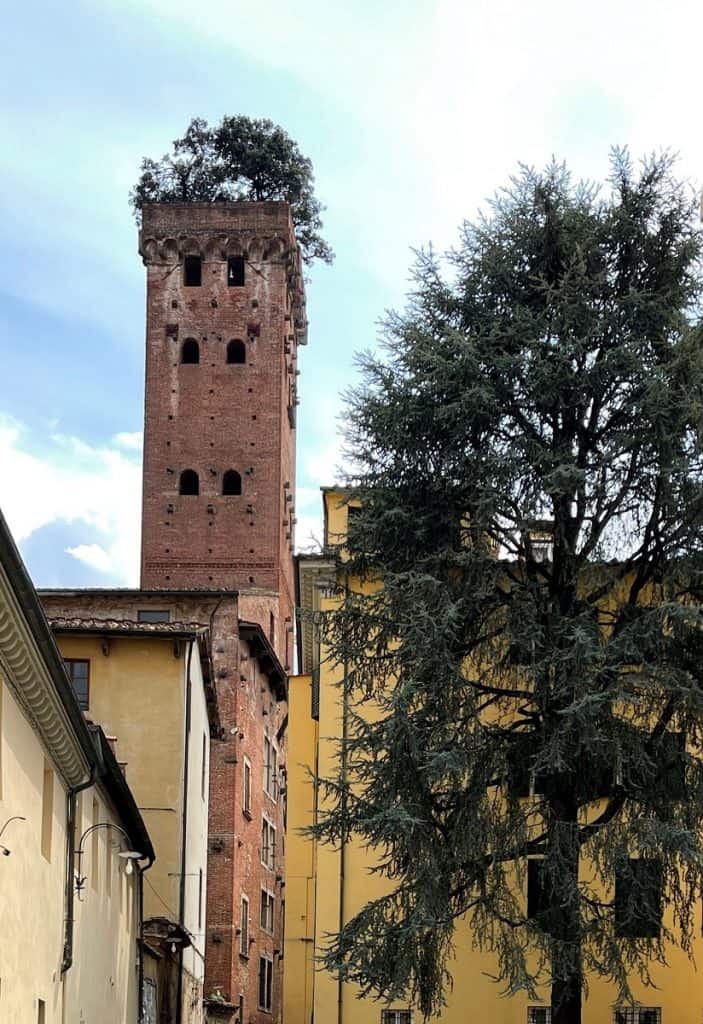
One of the few remaining towers in Lucca, Guinigi, is unique because Oak trees are growing on the top. Yes, rooftop gardens were popular even way back then. You can walk to the top of the Tower; it is just 233 steps up and back. My knees said no.
Next on our list is Casa Natale, the birthplace and museum of the great opera composer Puccini. Walking through the walled village, you feel like being back in time. Passing the statue of Puccini, we know we are getting close.
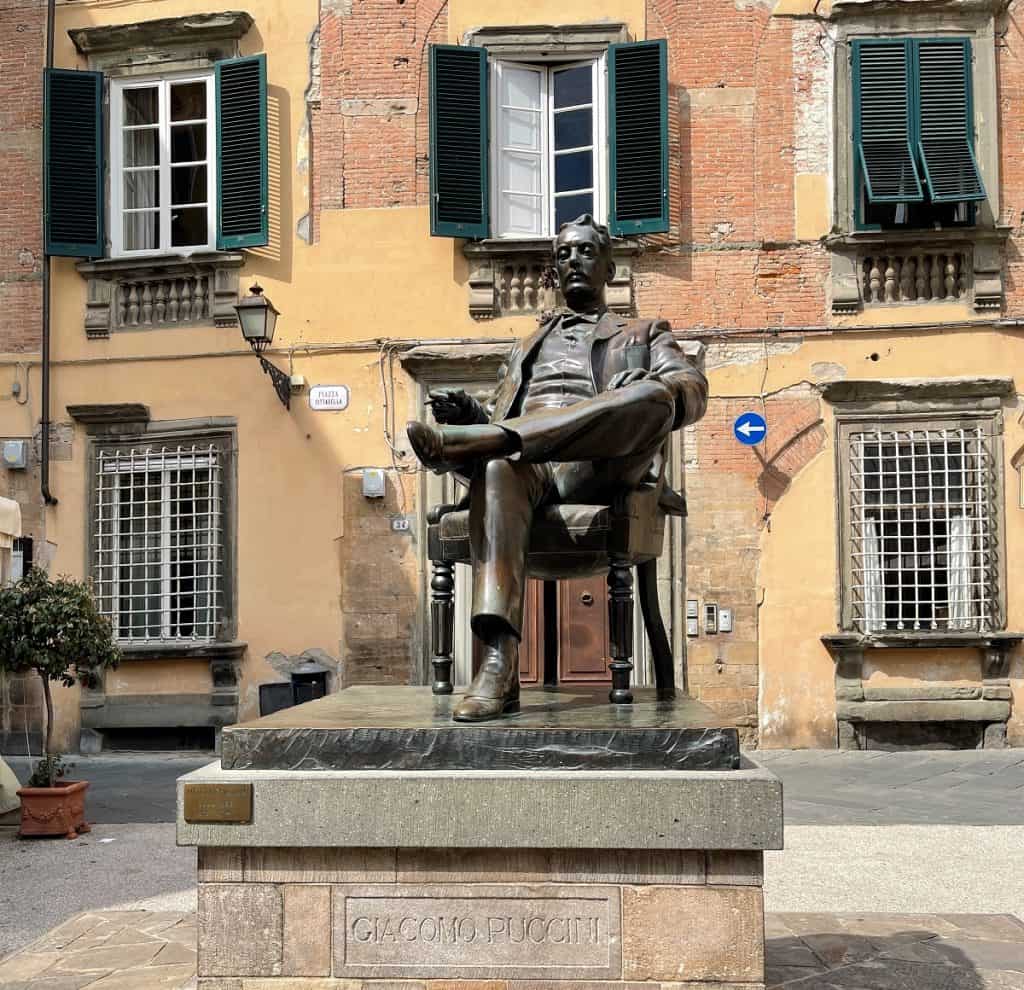
In Piazza Napoleone, we find a street market with loaves of bread, fruits, cheese, and vegetables. Adjacent to the market is a colorful Carousel and stalls with toys for children.
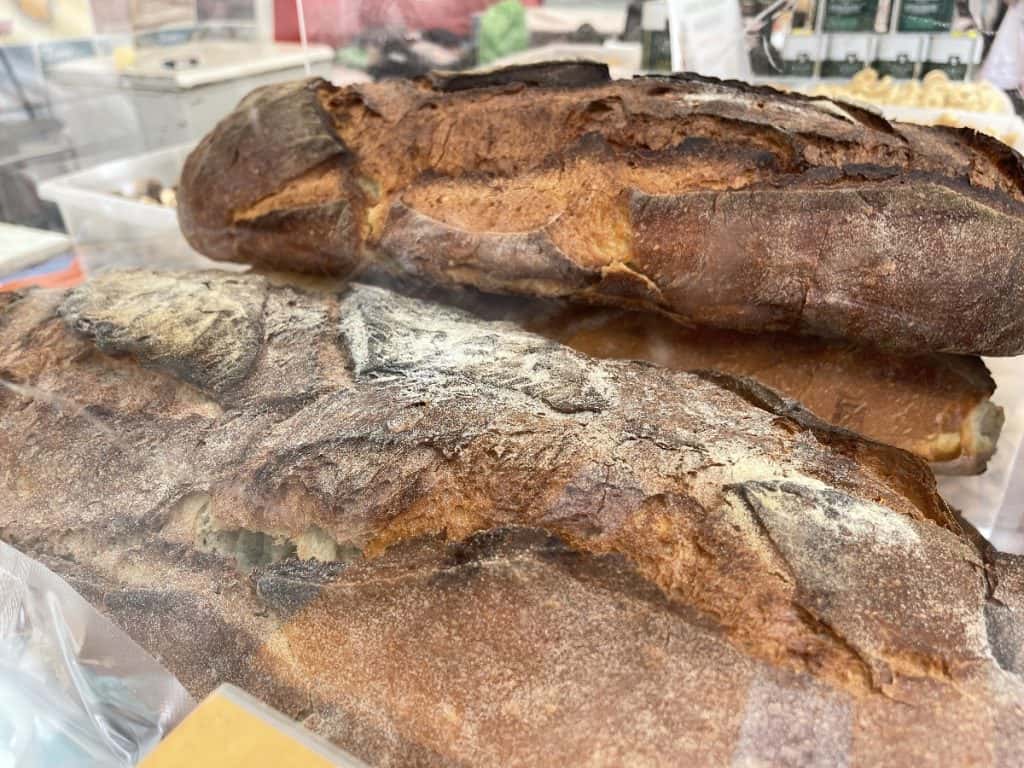
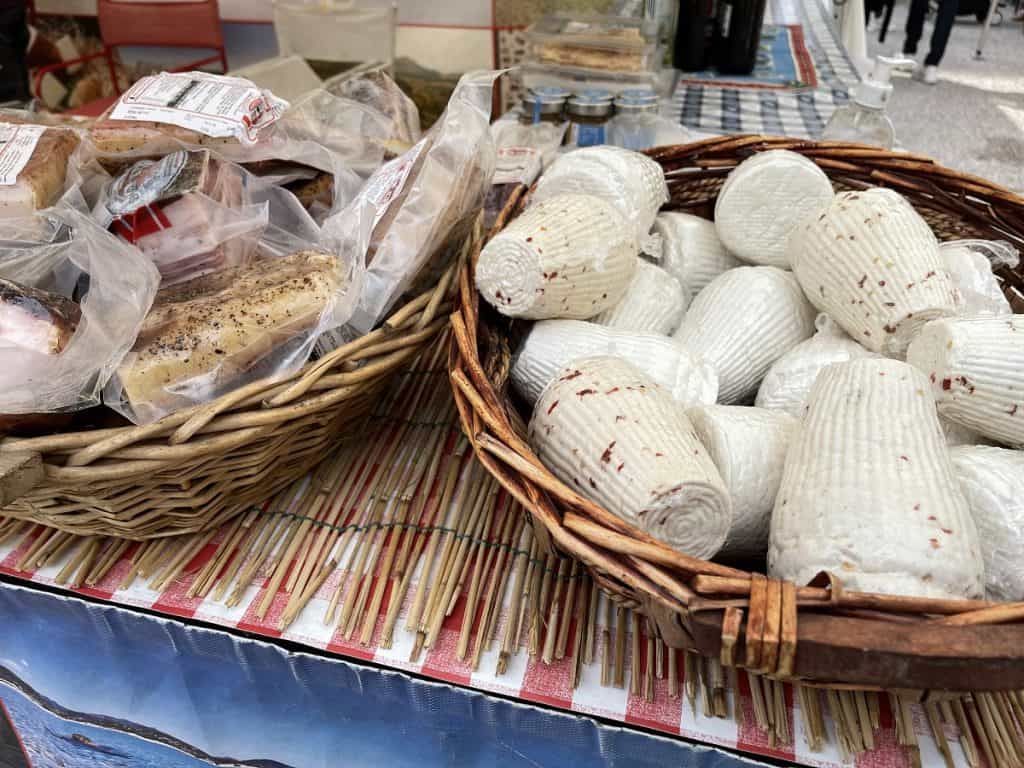
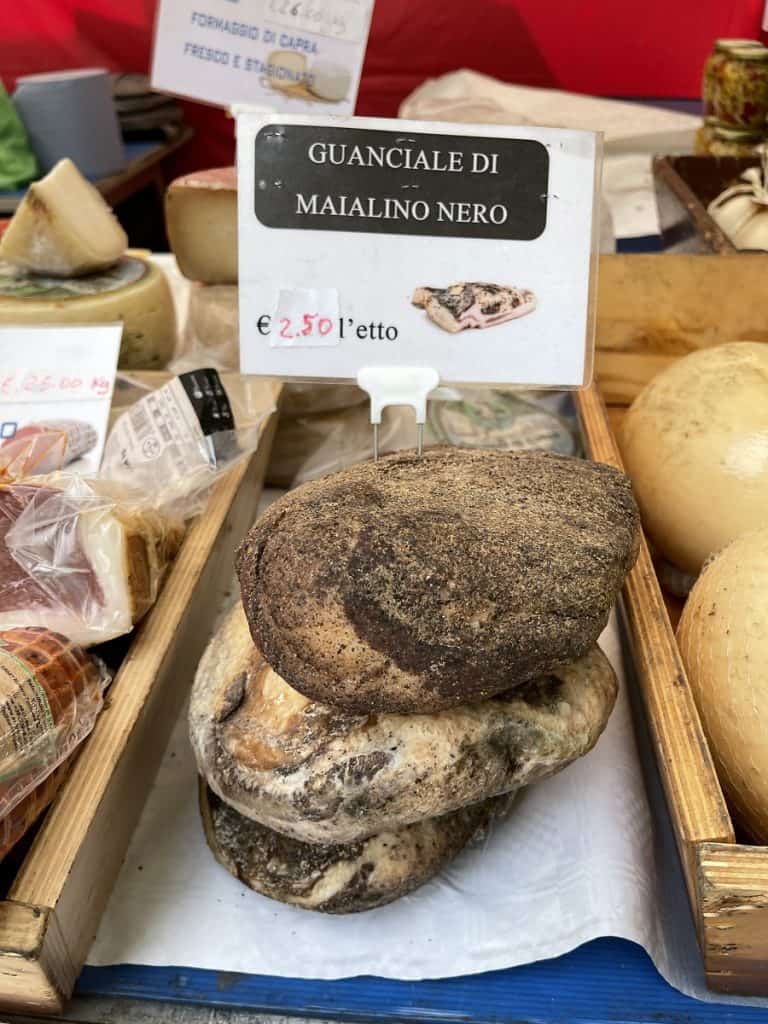
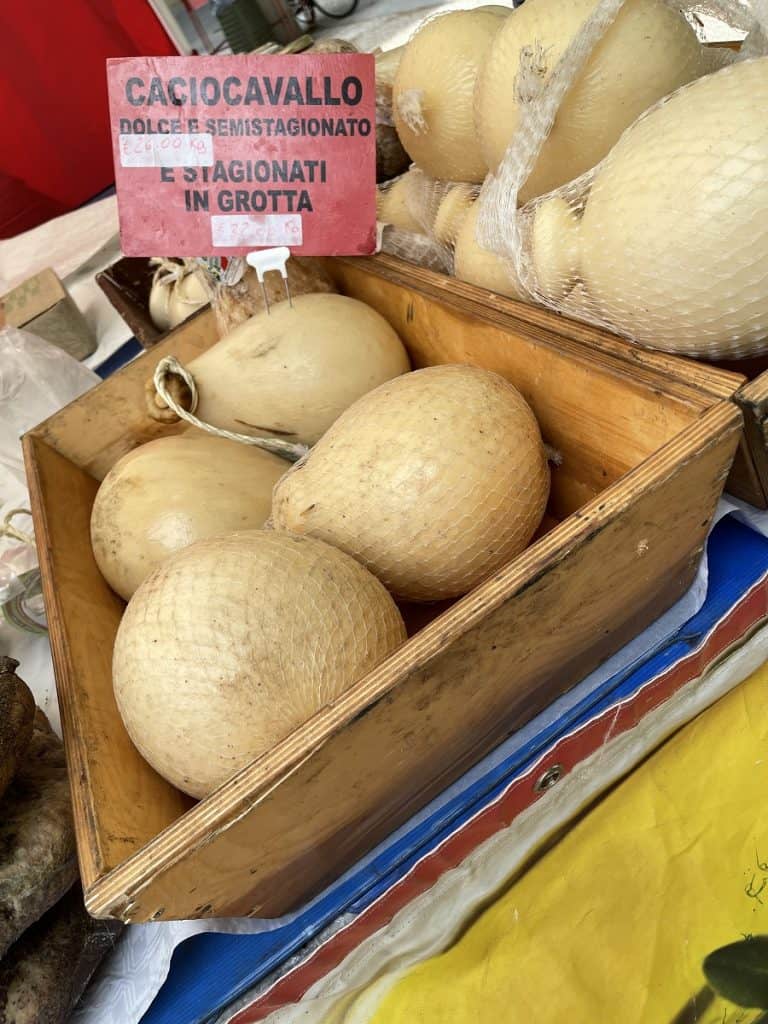
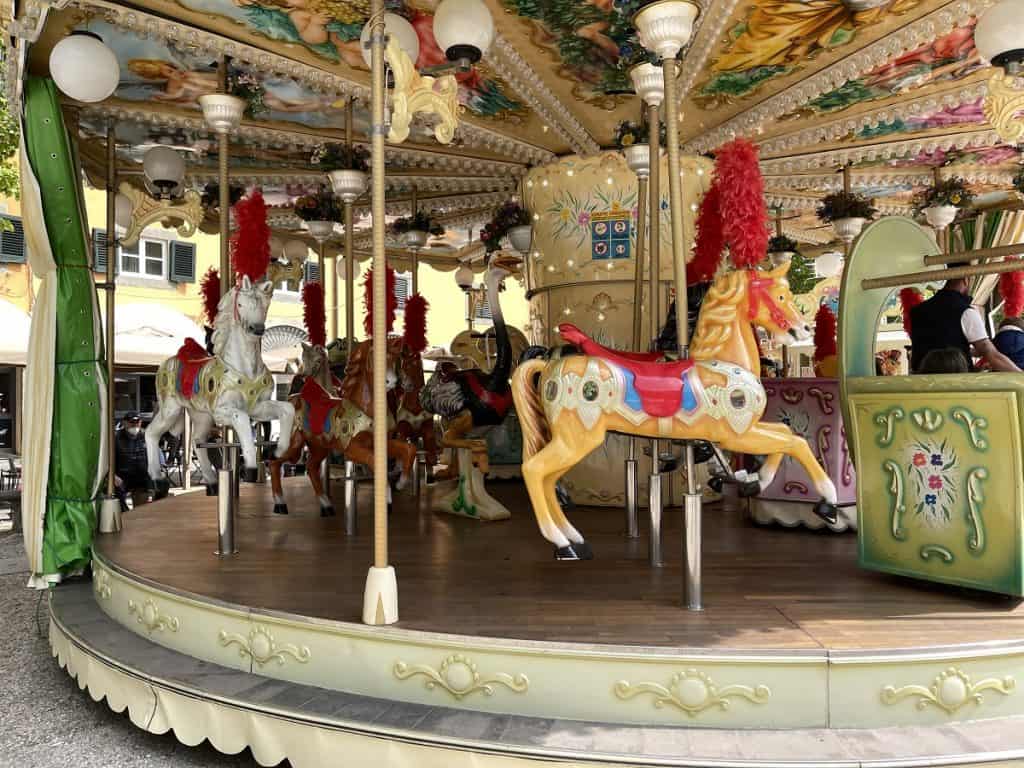
A bit further up the road is the Basilica di San Michele. First mentioned in 795, the Church was rebuilt sometime after 1070 under Pope Alexander II. The intricate façade of San Michele dates from the 13th century, but numerous sculptures and inlays were remade in the 19th century.
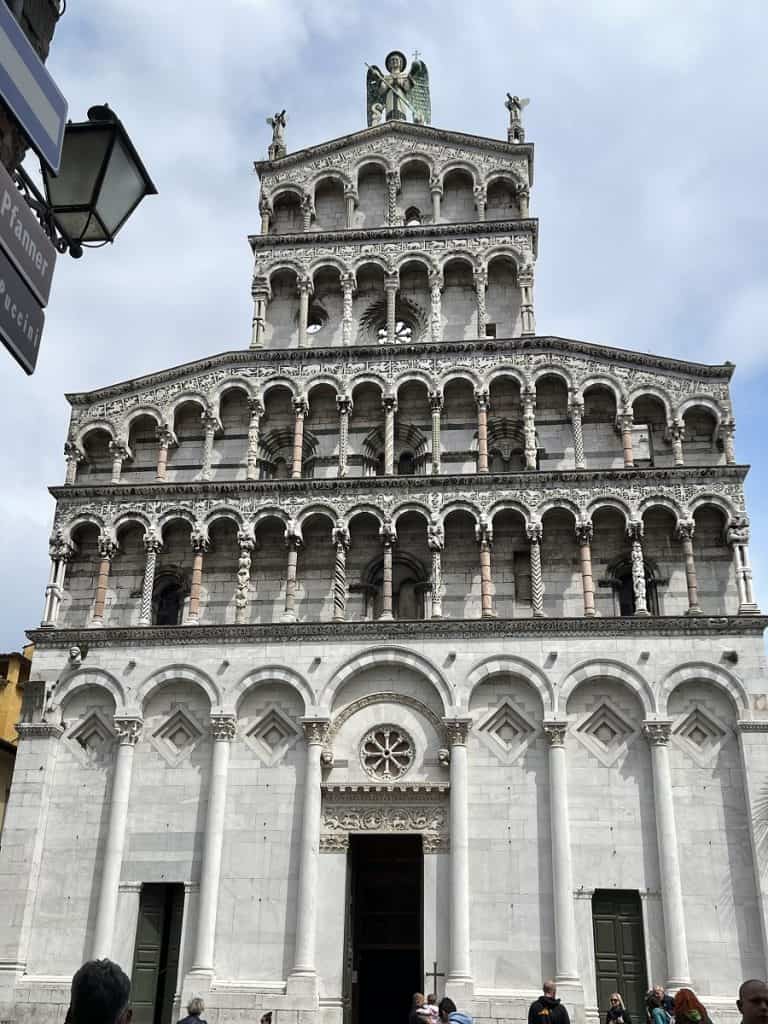
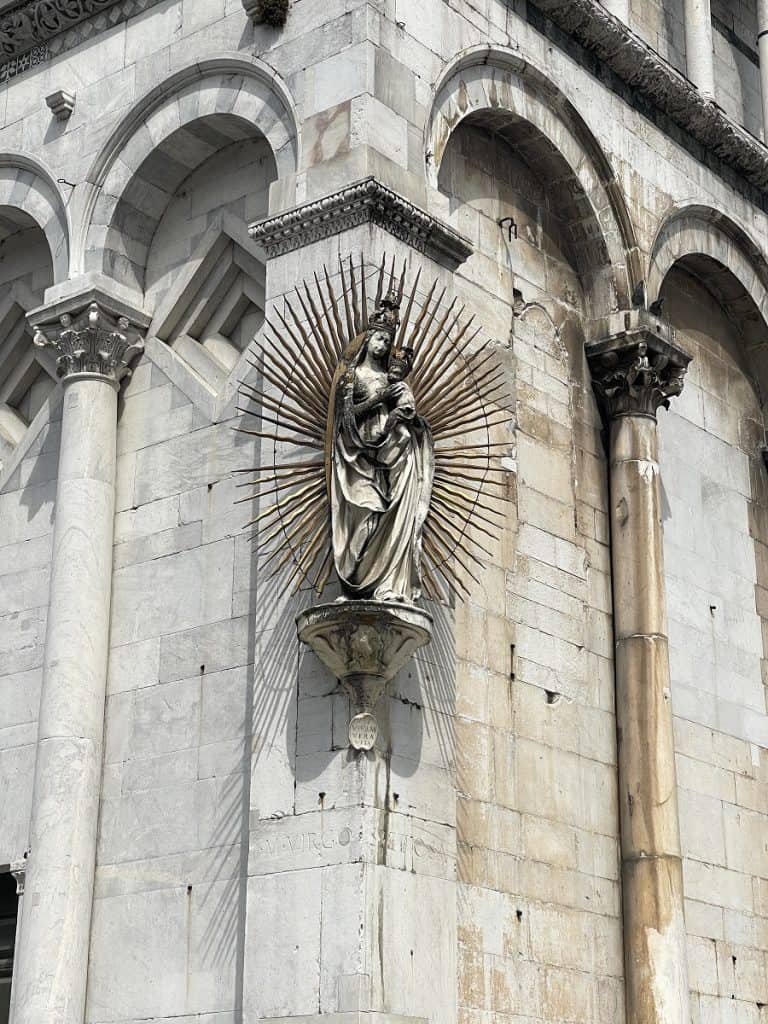
Via di Poggio is directly in front of the Basilica, and the Puccini Museum is 1/2 a block down this alley. We are not big souvenir buyers, but our good friend and house watcher is a true lover of classical music and Puccini. So we pick up a DVD and some sheet music for her as a thank-you gift.
As a way to see Lucca’s whole village, we head for the wall. You can walk the entire circle. It’s about 3.3 miles in total. You can look down into the streets and plazas from a higher vantage. We only do around half the wall as we need to get back to our meeting point.
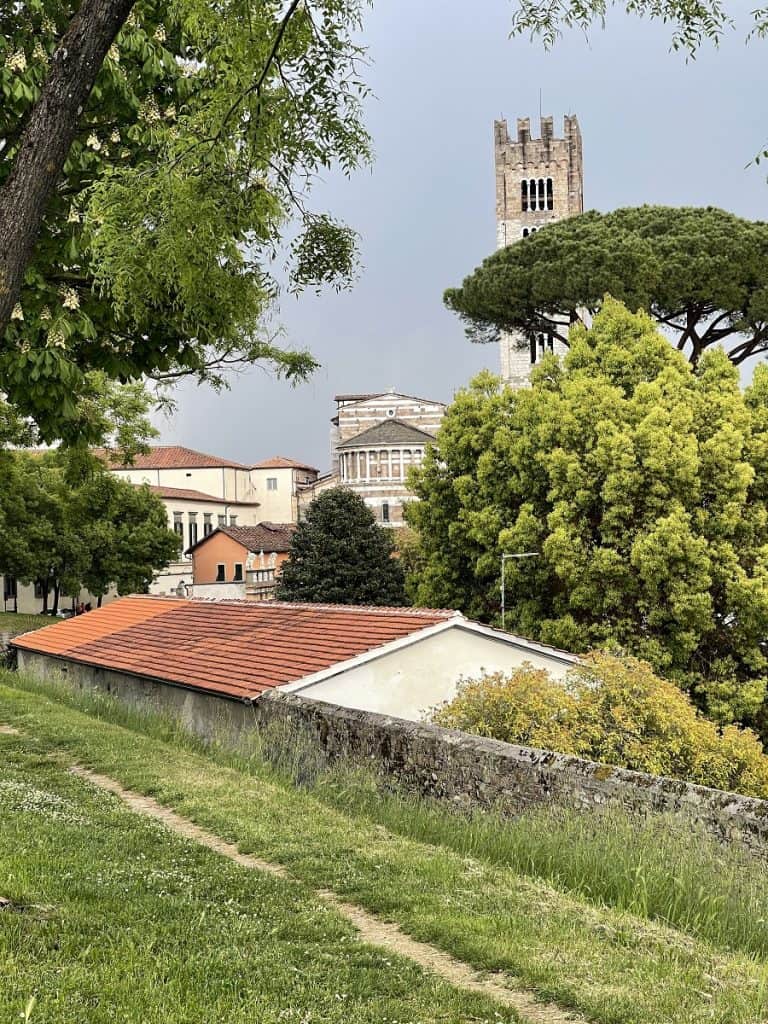
Returning To the City Of Livorno
Our guide gives us some history on the drive back to the port city. She tells us that the Medici family made Livorno into today’s thriving City by cultivating trade at its port. Since we have a little extra time before returning to our ship, the driver gives us a quick tour.
We come into town on Viale Giosue Carducci and circle the Piazza della Repubblica before heading down Via Grande. Our guide points out the Catterdrale di San Francesco and a nice view of the Piazza Grande. Lastly, we take a quick run up Piazza del Pamiglione to view Fortezza Vecchia, the medieval fort of the City and its 11th-century watch tower.
As we arrive back at Porto Mediceo and the Reflection, our ship, we realize we probably could have just spent the day in Livorno itself. Well, there will be a next time. For now, we say Arrivederci Livorno!
